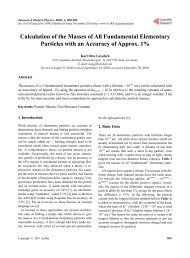Ligand-based Design - Leibniz Institute for Age Research
Ligand-based Design - Leibniz Institute for Age Research
Ligand-based Design - Leibniz Institute for Age Research
Create successful ePaper yourself
Turn your PDF publications into a flip-book with our unique Google optimized e-Paper software.
-2010-<br />
3D Structures of Biological Macromolecules<br />
Part 4: Drug <strong>Research</strong> and <strong>Design</strong><br />
Jürgen Sühnel<br />
jsuehnel@fli<br />
jsuehnel@fli-leibniz.de<br />
jsuehnel@fli leibniz.de<br />
<strong>Leibniz</strong> <strong>Institute</strong> <strong>for</strong> <strong>Age</strong> <strong>Research</strong>, Fritz Lipmann <strong>Institute</strong>,<br />
Jena Centre <strong>for</strong> Bioin<strong>for</strong>matics<br />
Jena / Germany<br />
Supplementary Material: www.fli-leibniz.de/www_bioc/3D/
Example of Drug Discovery
Example of Drug Discovery
Example of Drug Discovery<br />
Pacific yew tree<br />
(Eibe)
Drug <strong>Research</strong> is<br />
the Search <strong>for</strong> a Needle in a Haystack.<br />
www.kubinyi.de
Development of Drug <strong>Research</strong><br />
www.kubinyi.de
Drug Timeline<br />
www.kubinyi.de
Drug Timeline<br />
www.kubinyi.de
Costs in Drug <strong>Research</strong><br />
4 Cost <strong>for</strong> discovering and developing a new drug:<br />
several € 100 million up to € 1000 million (average € 802 M)<br />
4 Time to market:<br />
10 – 15 years
Global Company Sales 2006
Top Ethical Drugs by Sales in 2006<br />
(Lowering blood cholesterol)<br />
(Asthma treatment)<br />
(Inhibits blood clots)<br />
(Proton pump inhibitor; treatment of dyspepsia, peptic ulcer disease, …)<br />
(Calcium channel blocker; anti-hypertensive agent)<br />
http://www.p-d-r.com/ranking/Top_100_Ethical_Drugs_by_Sales.pdf
New Products Marketed <strong>for</strong> the First Time<br />
http://www.p-d-r.com/ranking/Prous_TYND_2005.pdf
Disciplines Involved in Drug Development<br />
Molecular Conceptor
The Role of Molecular Structure<br />
Molecular Conceptor
The Pharmacophore Concept<br />
Molecular Conceptor
Mechanisms of Drug Action – Definitions I<br />
www.kubinyi.de
Mechanisms of Drug Action – Definitions II<br />
www.kubinyi.de
Serendipity - Penicillin<br />
Molecular Conceptor
Serendipity - Penicillin
Serendipity - Aspirin<br />
Serendipity - Aspirin<br />
Molecular Conceptor
Strategies in Drug <strong>Design</strong><br />
www.kubinyi.de
Computational Approaches to Drug <strong>Research</strong><br />
TTarget t id identification tifi ti<br />
Lead discovery<br />
Lead optimization<br />
<strong>Ligand</strong>-<strong>based</strong> design<br />
Receptor-<strong>based</strong> design (Docking)<br />
D t b i (Vi t l i )<br />
Database screening (Virtual screening)<br />
Supporting combinatorial chemistry
3D Structures in Drug <strong>Design</strong><br />
www.kubinyi.de
Lead Structure Identification<br />
www.kubinyi.de
Lead Structure Search Pipeline<br />
www.kubinyi.de
Lead Structures:<br />
Endogenous Neurotransmitters<br />
www.kubinyi.de
Lead Structures:<br />
Endogenous Neurotransmitters<br />
Neurotransmitters are chemicals that are used to relay, amplify and<br />
modulate electrical signals between a neuron and another cell.<br />
Acetylcholine: voluntary movement of the muscles<br />
Noradrenaline: wakefulness or arousal<br />
Dopamine: voluntary movement and emotional arousal<br />
Serotonin: sleep and temperature regulation<br />
GABA: (gamma (g aminobutryic y acid) ) - motor behaviour<br />
www.kubinyi.de
Lead Optimization<br />
www.kubinyi.de
<strong>Ligand</strong> <strong>Ligand</strong>-<strong>based</strong> <strong>based</strong> <strong>Design</strong>: What is QSAR ?
<strong>Ligand</strong> <strong>Ligand</strong>-<strong>based</strong> <strong>based</strong> <strong>Design</strong>: Basic Requirements <strong>for</strong> QSAR Studies
<strong>Ligand</strong> <strong>Ligand</strong>-<strong>based</strong> <strong>based</strong> <strong>Design</strong>: QSAR<br />
HHansch h analysis l i iis th the iinvestigation ti ti of f the th quantitative tit ti relationship l ti hi bbetween t th the<br />
biological activity of a series of compounds and their physicochemical substituent<br />
or global parameters representing hydrophobic, electronic, steric and other effects<br />
using multiple regression correlation methodology<br />
methodology.<br />
www.kubinyi.de
<strong>Ligand</strong> <strong>Ligand</strong>-<strong>based</strong> <strong>based</strong> <strong>Design</strong>: QSAR<br />
www.kubinyi.de
<strong>Ligand</strong> <strong>Ligand</strong>-<strong>based</strong> <strong>based</strong> <strong>Design</strong>: QSAR Parameters<br />
www.kubinyi.de
<strong>Ligand</strong> <strong>Ligand</strong>-<strong>based</strong> <strong>based</strong> <strong>Design</strong>: QSAR Parameters
<strong>Ligand</strong> <strong>Ligand</strong>-<strong>based</strong> <strong>based</strong> <strong>Design</strong>: QSAR Parameters - Lipophilicity
<strong>Ligand</strong> <strong>Ligand</strong>-<strong>based</strong> <strong>based</strong> <strong>Design</strong>: QSAR Parameters<br />
www.kubinyi.de
<strong>Ligand</strong> <strong>Ligand</strong>-<strong>based</strong> <strong>based</strong> <strong>Design</strong>: QSAR Parameters<br />
www.kubinyi.de
<strong>Ligand</strong> <strong>Ligand</strong>-<strong>based</strong> <strong>based</strong> <strong>Design</strong>: QSAR Parameters<br />
‐ reaction constant<br />
‐ substituent constant<br />
www.kubinyi.de
<strong>Ligand</strong> <strong>Ligand</strong>-<strong>based</strong> <strong>based</strong> <strong>Design</strong>: QSAR Parameters<br />
www.kubinyi.de
<strong>Ligand</strong> <strong>Ligand</strong>-<strong>based</strong> <strong>based</strong> <strong>Design</strong>: QSAR Parameters<br />
www.kubinyi.de
<strong>Ligand</strong> <strong>Ligand</strong>-<strong>based</strong> <strong>based</strong> <strong>Design</strong>: QSAR Parameters<br />
www.kubinyi.de
<strong>Ligand</strong> <strong>Ligand</strong>-<strong>based</strong> <strong>based</strong> <strong>Design</strong>: A QSAR Success Story<br />
www.kubinyi.de
<strong>Ligand</strong> <strong>Ligand</strong>-<strong>based</strong> <strong>based</strong> <strong>Design</strong>: A QSAR Success Story<br />
pI50 – concentration of test compound required to reduce the protein content of cell by 50%<br />
pI 50<br />
www.kubinyi.de
<strong>Ligand</strong> <strong>Ligand</strong>-<strong>based</strong> <strong>based</strong> <strong>Design</strong>: 3D 3D-QSAR QSAR CoMFA<br />
www.kubinyi.de
Molecular Superposition of D Receptor <strong>Ligand</strong>s<br />
www.kubinyi.de
<strong>Ligand</strong> <strong>Ligand</strong>-<strong>based</strong> <strong>based</strong> <strong>Design</strong>: 3D 3D-QSAR QSAR CoMFA<br />
www.kubinyi.de
<strong>Ligand</strong> <strong>Ligand</strong>-<strong>based</strong> <strong>based</strong> <strong>Design</strong>: 3D 3D-QSAR QSAR CoMFA<br />
www.kubinyi.de
<strong>Ligand</strong> <strong>Ligand</strong>-<strong>based</strong> <strong>based</strong> <strong>Design</strong>: 3D 3D-QSAR QSAR CoMFA<br />
Partial least squares regression (PLS regression) is a statistical method that finds a linear regression model by<br />
projecting the predicted variables and the observable variables to a new space. Because both the X and Y data are<br />
projected to new spaces, spaces the PLS family of methods are known as bilinear factor models. models<br />
PLS is used to find the fundamental relations between two matrices (X and Y), i.e. a latent variable approach to<br />
modeling the covariance structures in these two spaces. A PLS model will try to find the multidimensional direction<br />
in the X space that explains the maximum multidimensional variance direction in the Y space space. PLS‐regression is<br />
particularly suited when the matrix of predictors has more variables than observations, and when there<br />
is multicollinearity among X values. By contrast, standard regression will fail in these cases.<br />
PLS regression is an important step in PLS path analysis analysis, a multivariate data analysis technique that employs latent<br />
variables. This technique is often referred to as a <strong>for</strong>m of variance‐<strong>based</strong> or component‐<strong>based</strong> structural equation<br />
modeling.<br />
Partial least squares was introduced by the Swedish statistician Herman Wold Wold, who then developed it with his son son,<br />
Svante Wold, a professor of chemometrics at Umeå University. An alternative term <strong>for</strong> PLS (and more correct<br />
according to Svante Wold [3] ) is projection to latent structures, but the term partial least squares is still dominant in<br />
many areas. It is widely applied in the field of chemometrics, in sensory evaluation, and more recently, in the analysis<br />
of functional brain imaging data [4]<br />
of functional brain imaging data.
Electrostatic and Van Van-der der-Waals Waals Interactions
<strong>Ligand</strong> <strong>Ligand</strong>-<strong>based</strong> <strong>based</strong> <strong>Design</strong>: 3D 3D-QSAR QSAR CoMFA<br />
Comparative<br />
Molecular<br />
Field<br />
Analysis
Receptor Receptor-<strong>based</strong> <strong>based</strong> <strong>Design</strong> ( (Structure Structure-<strong>based</strong> <strong>based</strong> <strong>Design</strong>)<br />
Molecular Conceptor
Receptor Receptor-<strong>based</strong> <strong>based</strong> <strong>Design</strong> ( (Structure Structure-<strong>based</strong> <strong>based</strong> <strong>Design</strong>)<br />
Molecular Conceptor
Receptor Receptor-<strong>based</strong> <strong>based</strong> <strong>Design</strong>: Docking<br />
Molecular Conceptor
Receptor Receptor-<strong>based</strong> <strong>based</strong> <strong>Design</strong>: Docking<br />
Molecular Conceptor
Receptor Receptor-<strong>based</strong> <strong>based</strong> <strong>Design</strong>: Docking<br />
Molecular Conceptor
Hydrophobic Amino Acids<br />
Molecular Conceptor
Receptor Receptor-<strong>based</strong> <strong>based</strong> <strong>Design</strong>: Docking<br />
Molecular Conceptor
H-Bond Bond Properties of Amino Acids<br />
Molecular Conceptor
Receptor Receptor-<strong>based</strong> <strong>based</strong> <strong>Design</strong>: HH-bond<br />
bond Effect<br />
IC50 -<br />
Drug concentration<br />
required <strong>for</strong> 50% inhibition of a<br />
biological effect<br />
Molecular Conceptor
Receptor Receptor-<strong>based</strong> <strong>based</strong> <strong>Design</strong>: HH-bond<br />
bond Effect<br />
www.kubinyi.de
Charge Properties of Amino Acids<br />
Molecular Conceptor
Receptor Receptor-<strong>based</strong> <strong>based</strong> <strong>Design</strong>: Salt Bridge<br />
116.<br />
Molecular Conceptor
Receptor Receptor-<strong>based</strong> <strong>based</strong> <strong>Design</strong>: Docking<br />
Molecular Conceptor
Receptor Receptor-<strong>based</strong> <strong>based</strong> <strong>Design</strong>: SAR (Pharmacophore<br />
Pharmacophore Features)<br />
Molecular Conceptor
Receptor Receptor-<strong>based</strong> <strong>based</strong> <strong>Design</strong>: DNA Receptor<br />
Molecular Conceptor
Receptor Receptor-<strong>based</strong> <strong>based</strong> <strong>Design</strong>: DNA Intercalating <strong>Age</strong>nts<br />
Molecular Conceptor
Receptor Receptor-<strong>based</strong> <strong>based</strong> <strong>Design</strong>: DNA Intercalating <strong>Age</strong>nts<br />
Molecular Conceptor
Receptor Receptor-<strong>based</strong> <strong>based</strong> <strong>Design</strong>: AIDS Drugs
Receptor Receptor-<strong>based</strong> <strong>based</strong> <strong>Design</strong>: AIDS Drugs
Combinatorial Diversity in Nature<br />
www.kubinyi.de
Classical vs. Combinatorial Chemistry<br />
ww.kubinyi.de
Combinatorial Library<br />
ww.kubinyi.de
Combinatorial Library<br />
ww.kubinyi.de
Types and Features of Combinatorial Libraries<br />
ww.kubinyi.de
Receptor Receptor-<strong>based</strong> <strong>based</strong> <strong>Design</strong>: Virtual Screening<br />
Virtual Screening:<br />
Select subsets of compounds <strong>for</strong> assay that are more likely to contain<br />
active hits than a sample chosen at random<br />
Time Scales:<br />
Docking of 1 compound 30 s<br />
(SGI R10000 processor)<br />
Docking of the 1.1 million data set 6 days<br />
(64-processor SGI ORIGIN)<br />
ACD-SC: Database from Molecular <strong>Design</strong> Ltd.<br />
Agonists: Known active compounds<br />
Docking of ligands to the estrogen receptor<br />
(nuclear hormone receptor)
Receptor Receptor-<strong>based</strong> <strong>based</strong> <strong>Design</strong>: Virtual Screening
Lipinski‘s „Rule Rule of Five“ Five<br />
Compounds are likely to have a good absorption and permeation<br />
in biological systems and are thus more likely to be successful drug candidates<br />
if they meet the following criteria:<br />
•5 or fewer H-bond donors<br />
•10 or fewer H-bond acceptors<br />
•Molecular weight less than or equal to 500 daltons<br />
•Calculated log P less than or equal to 5<br />
•„Compound classes that are substrates <strong>for</strong> biological transporters are exceptions to the rule“.<br />
Druggable gg compounds p
ADME<br />
ADME
The Future: Pharmacogenomics and Personalized Medicine<br />
www.kubinyi.de
Prediction Issues<br />
www.kubinyi.de




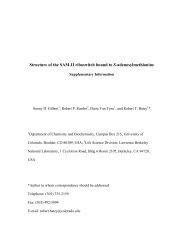

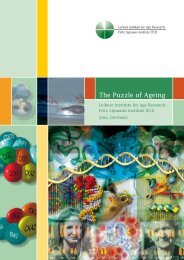

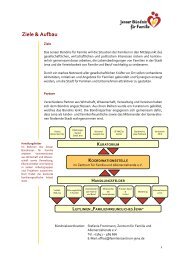



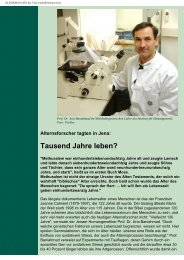

![Programm [pdf]](https://img.yumpu.com/20944039/1/184x260/programm-pdf.jpg?quality=85)
